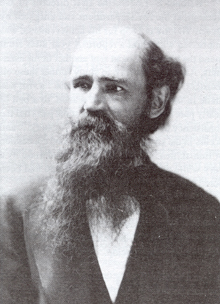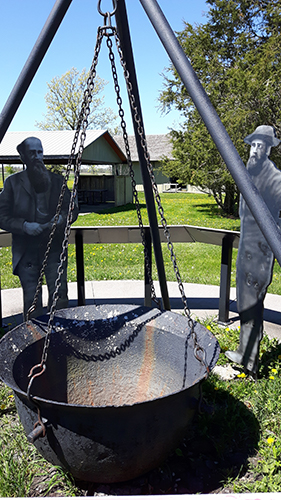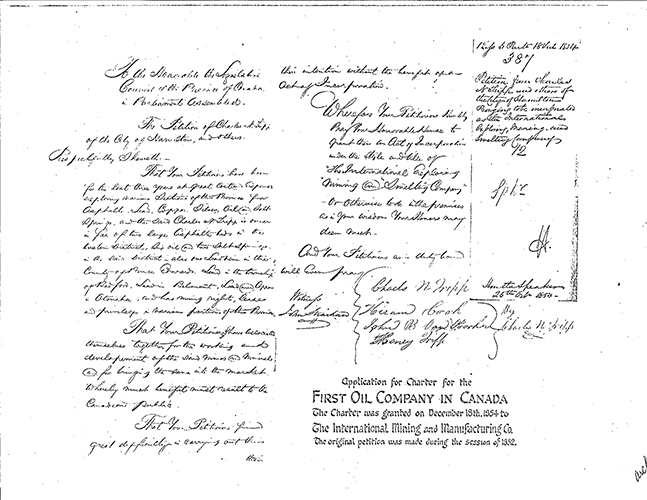Charles and Henry Tripp

Henry Tripp
It all started with an account from a surveyor, Alexander Murray, of bitumen deposits (gum beds) in Enniskillen Township, which appeared in William Logan's Report of Progress, 1851. The gum beds are deposits of oil that have reached the surface of the ground where the lighter oils and gases evaporate leaving a 'gum' or tarry patch. Henry Tripp heard about this report and alerted his brother, Charles Nelson Tripp, who was foreman of a stove foundry in Bath, Ontario and also worked lead and copper veins near Bath. Charles Tripp jumped at this opportunity. His vision was to make asphalt from the gum bed. To make the asphalt he first dug the surface deposits of bitumen, boiled it in open cast iron vessels venting the lighter products into the atmosphere. In 1852, the Lambton County Atlas locates Charles Tripp in Enniskillen and stated that he had 'erected building and machinery for the manufacture of asphalt.' By 1853, Tripp had bought a 200-acre parcel of land- Concession 2 lot 16 (the site of the Oil Museum of Canada, National Historic Site). By 1855, he had bought 1350 acres of prime oil land in Enniskillen.

Charles Tripp boiled bitumen in open cast iron vessels.
Tripp had many obstacles to overcome. For one, Enniskillen Township at that time was a swamp. It was largely uninhabited because no European settler wanted to be there. It was heavily forested and had thick clay soil, which limited any drainage so even in the summer, rain water lay on the ground.. Topping that off, there were two large, smelly gum beds. Settlers bypassed this area to set up farms elsewhere. The roads that existed in the area were little more than paths. Getting product to market proved the most difficult for Tripp. Even so, he persisted. In 1853, Tripp took samples from his gum beds to Dr. Thomas Antisell, a New York chemist, and Thomas McIlwraith, manager of the Hamilton Gas Light Company. Although both specialists suggested using his asphalt for “lighting oil”, Charles ignored them. He wouldn't be swayed from his great visions and plans, however, there was little demand for his product at that time. Tripp was a man ahead of his time.
During the 1852 Parliamentary session, Charles Tripp sought a petition to form a company, and it was granted December 18, 1854; two weeks before the Pennsylvania Rock Oil Co. in the United States. The International Mining and Manufacturing Company, was the first oil company in North America. The directors were Charles Nelson Tripp, Hiram Cook; a wood merchant from Hamilton, John Van Voorhis; a wood merchant and contractor from Hamilton, and Henry Tripp--believed to be living in Petersburg, Virginia. The charter for this company stated that they owned the “rights to explore for asphalt beds, oil and salt springs, and to manufacture products from these sources for various uses”.

Charter 1854 International Mining and Manufacturing company.
The future was looking bright when William Logan (Logan's Report of Progress) asked Tripp to submit samples of asphalt for the 1855 International Exhibition in Paris, France. He was awarded honourable mention for his exhibits. It was through this attention that the City of Paris, sent him an order of enough asphalt to pave their streets.
He must have been ecstatic at such a larger order of three boatloads. The winter months of 1855-56 were extremely busy processing his asphalt, transporting it over frozen ground by sleigh to Port Sarnia where it was loaded onto ships. However, it must have been too large of an expense to get the product to Paris; by October 1855, Tripp was having financial problems. In 1856, he sold lots 16 and 17 concession 2 to a group of men from Hamilton. One of these men was James Miller Williams, who owned the business where Tripp bought wagons. Williams was ready for a career change and went back to Enniskillen with Tripp. They worked together for a short time, but Tripp eventually left Enniskillen in 1858, bankrupt.
Charles Tripp died still in pursuit of success. During his lifetime he had organized many companies to develop minerals, oil, copper, lead, zinc, and iron in Louisiana and Texas. Sadly, he seemed destined to failure. He had great ideas and was an intelligent man, but for all that, he could not find the wealth he so desired. Tripp “knew more, practically, about the mineral wealth of every southern state than any other man”, and yet he languished in debt and died penniless. (Hope Morritt, Rivers of Oil, p.78)
In 1866, Tripp briefly returned to Canada, but on his trip back through New Orleans, he died in a hotel on September 30, 1866 from "congestion of the brain".


 Subscribe to this page
Subscribe to this page